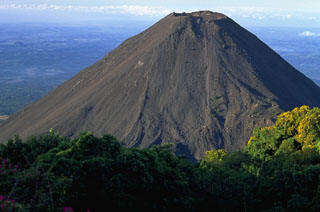Report on Izalco (El Salvador) — February 1999
Bulletin of the Global Volcanism Network, vol. 24, no. 2 (February 1999)
Managing Editor: Richard Wunderman.
Izalco (El Salvador) Strong fumarolic activity around the summit crater
Please cite this report as:
Global Volcanism Program, 1999. Report on Izalco (El Salvador) (Wunderman, R., ed.). Bulletin of the Global Volcanism Network, 24:2. Smithsonian Institution. https://doi.org/10.5479/si.GVP.BGVN199902-343030
Izalco
El Salvador
13.813°N, 89.633°W; summit elev. 1950 m
All times are local (unless otherwise noted)
During fieldwork on Santa Ana volcano in February, increased steaming was observed at the summit of Izalco relative to levels of previous years. Strong fumarolic activity occurred along the entire circumference of the 250-m-wide summit crater, with the exception of the NE side facing Cerro Verde. Activity was most vigorous at a vent on the N side of the crater floor, but was also strong along much of the inner rim of the crater and along its outer flanks. Steaming was observed over broad areas on the outer southern flanks to ~50 m below the rim, and on the W flank immediately N of a shoulder of the cone at ~1,800 m elevation, roughly 150 m below the summit. Activity had earlier been noticed to have increased in November 1998 following Hurricane Mitch. Most of the steaming was water vapor, and the increased activity was attributed to saturation of the still-warm cone by heavy rains accompanying the hurricane.
Geological Summary. Volcán de Izalco began growing in 1770 CE on the southern flank of Santa Ana volcano, eventually building a steep 650-m-high stratovolcano truncated by a 250-m-wide summit crater. Frequent Strombolian eruptions during the two centuries prior to the cessation of activity in 1966 provided a night-time beacon for ships, causing it to be known as El Faro, the "Lighthouse of the Pacific." The dominantly basaltic andesite tephra and lava flows are geochemically distinct from those of both Santa Ana and its fissure-controlled flank vents. Lava flows have primarily erupted from flank vents, traveling as far as about 7 km south down the slopes of Santa Ana.
Information Contacts: Carlos Pullinger, Calle Padres Aguilar 448, Colonia Escalon, San Salvador, El Salvador; Demetrio Escobar, Centro de Investigaciones Geotecnicas (CIG), Final Blvd. Venezuela y calle a La Chacra, Apdo. Postal 109, San Salvador, El Salvador; Lee Siebert and Paul Kimberly, Global Volcanism Program, Smithsonian Institution.

